How to See the Best of Milan in One Day: A Complete Guide
Milan was a bit of a surprise for us. We had a certain preconceived notion – several, really – about Italian cities that Milan shattered. Milan is a modern metropolis, making it feel very different from other famous Italian cities like Rome, Florence, and Venice, which are full of charming narrow alleyways and historic buildings.
That’s not to say that Milan doesn’t have those things, though. It does in parts of the city. But the overwhelming feeling we got walking around Milan is that it felt closer to a city like Paris, Berlin, or New York City than it did to Rome or Florence.
And, really, that’s one of our favorite parts about Italy. The fact that each region has such a strong sense of identity stemming from thousands of years ago gives each of Italy’s big cities a very unique vibe (for lack of a more sophisticated word), and Milan is no different.
It’s modern, while Rome is ancient. It’s huge, while Venice is tiny. It has more locals (or people who live there, at least) than tourists, while Florence is Disneyland.
Oh yeah, that reminds me – you will probably feel either like a slob, or like you’re very, very old at times in Milan. The presence of the fashion industry means that there’s a ton of stylish folks walking around, and sometimes the “stylish” will have you saying “is THAT how the kids are dressing these days?”
We’ve now been to Milan multiple times, and I (Matt here!) got to spend nearly a week in Milan exploring solo after sending my mom and brother back home on my last jaunt to Italy.
By that point, I had already done most of Milan’s major attractions – like the Duomo, Parco Sempione, and canals – and that trip allowed me to dive a level deeper to figure out what makes Milan special and, more importantly, what’s worth seeing, doing, and eating.
In this guide, we’re going to go through everything we think you need to know to make the most out of one day in Milan (this guide works both as an overnight in Milan or as a day trip to Milan).
We’ll start with some logistics, like getting around (spoiler: you’re going to want to use public transportation), and then move on to a detailed guide to spending one day in Milan that you can essentially copy and paste for your own trip (we support that kind of plagiarism!).
Our intention here is that, by the end of this guide, you have everything you need to plan an incredible day in Milan.
Sound good to you? Let’s get into it.
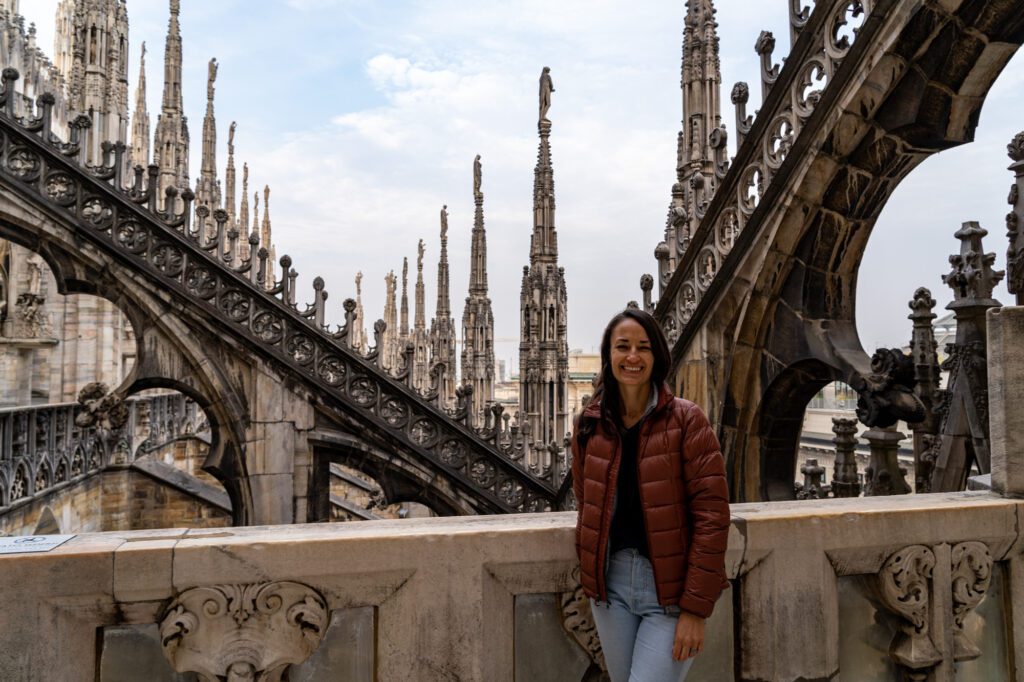
Disclaimer: Some of the links in this post, like hotel links, are affiliate links, meaning at no additional cost to you, we make a little bit of money if you click through and book. That being said, we would never recommend something to you that we don’t stand behind 100%.
What Can You See with One Day in Milan?
To be completely honest, we think the ideal amount of time to spend in Milan itself – not counting day trips or anything else outside the city limits – is probably two days (which is why we’ve also written a two day Milan itinerary).
Obviously, there is plenty more to do and see in Milan if you have more than one day, especially when you include day trips to places like Lake Como on the list.
However, we do believe you can see the highlights in Milan in just a day. Mostly because we’ve essentially done it ourselves. It’s going to be packed, but it’s doable.
Would more time be better so that you have a more leisurely pace? Yes, of course. We usually recommend doing no more than one major attraction in a day (like, for example, the Duomo and the Last Supper).
But, at the end of the day, if you’re reading this guide then you are probably visiting Milan with one day to spend in the city.
And if you have only one day, we’re here to help you make the most of it. Which means fitting both of those places in a single day while still leaving room to explore a little bit.
With a day in Milan, we’d recommend that you focus on three main sights; the Last Supper, the Duomo di Milano (specifically, the terraces), and the sprawling Parco Sempione. Of course that’s not all you’ll see, but those are the three anchors we’ll use for the itinerary below.
Getting Around Milan
Milan is Italy’s second biggest city behind Rome, and there’s a reason we’re bringing that up at the top of the “getting around” section.
It means that you’re going to have to cover a lot of ground to see its highlights in a single day.
Unlike many Italian cities, which are very walkable, Milan’s center feels a bit bigger and more spread out.
It’s also less charming and more modern, which means it doesn’t feel nearly as romantic as, say, Florence, Rome, or Venice, which we’re more than happy walking around for hours on end without getting bored.
While we absolutely love walking everywhere when we travel (we often get up to 25,000-30,000 steps in a single day), it’s just not practical in Milan when you only have a day.
The bottom line is that with such a short time in Milan, you’re going to want to use the city’s robust public transportation network to get from place to place to cut down on travel time.
Using Public Transportation in Milan
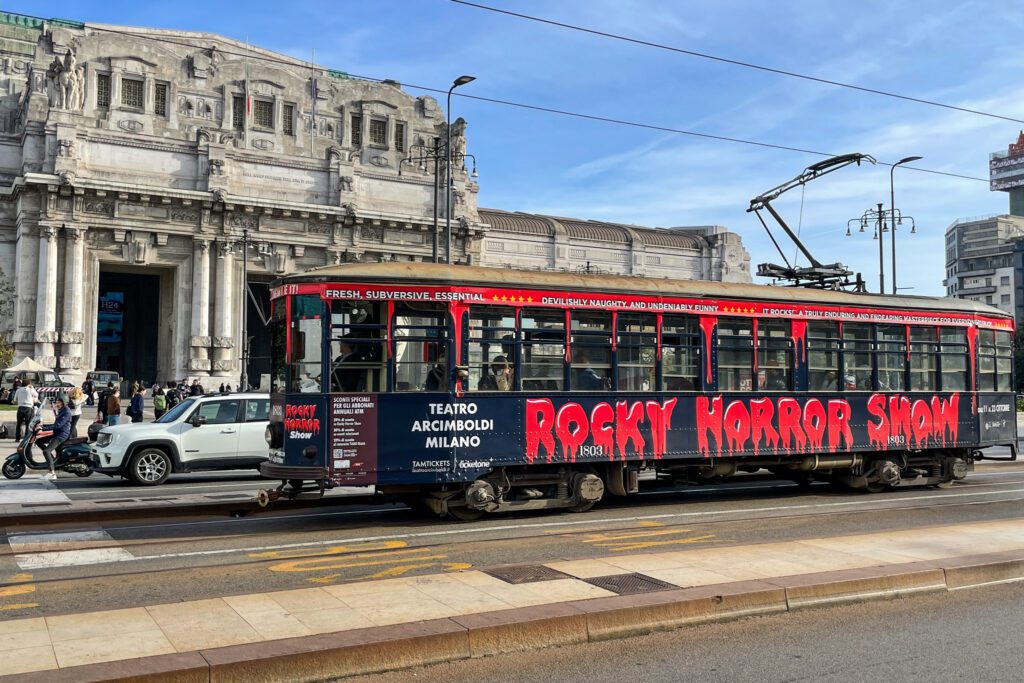
First of all, while Milan is plenty walkable given an unlimited amount of time, we highly, highly recommend using the metro, tram, and bus system to get around if you only have a day in Milan.
They’re clean, efficient, and connect most of the city center (sometimes with a transfer, but only sometimes).
For context, on our first trip to Milan when we only had a day before we moved on, we used public transportation 12 different times in 24 hours. We still walked plenty – 27,000 steps, to be nearly exact – but we would’ve walked double or triple that had we been doing everything on foot.
Your next question is probably something along the lines of “12 times? That must have cost a fortune!”
If we had paid the 2 Euros per ticket per person for each journey (only good for a single metro ride, too, so limited transfer potential), you’d be right. It would have cost us nearly 50 Euros between the two of us!
But we were lucky enough to discover the 24 Hour Pass, which covers all forms of public transportation in the center of Milan (which is all you’ll really need, save the trip to the airport if you need it, which will have to be bought separately – more on that in a second).
That pass, which was essential for our exploration of Milan and we highly recommend investing in, is only €7.60 a person. A steal, given our extensive use of the public transit system.
When I returned to Milan with my family, who only had 24 hours to see the city (though I had slightly longer), our first stop in the city was the ticket machines at the metro station under Milano Centrale to buy a 24 hour transit pass.
Here’s more on Milan’s public transportation network, which you should check out for the most up-to-date information.
Getting From the Train Station to the City Center
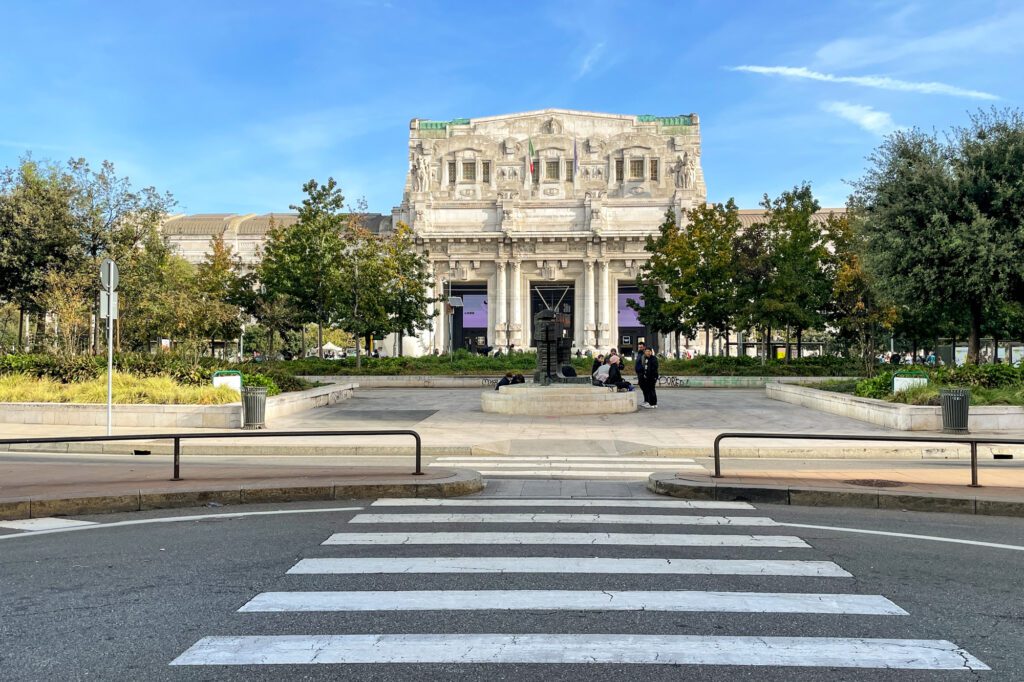
Milano Centrale is the main train station in Milan, and is the one you should shoot for if Milan is part of a broader Italy itinerary by train.
It’s also where you’ll likely end up if you fly into Milan because it’s easy to reach from either of Milan’s main airports, MXP and LIN (which, by the way, are the only two airports you should consider flying into if you’re arriving in Milan by plane).
Milano Centrale sits at the northern edge of the city center, and has plenty of bus, tram, and metro connections to the rest of the city.
All you’ll need to do is read the section on Milan’s public transportation above, plug in your accommodations to Google Maps, and off you go!
The same goes for Milan’s other train stations, though the connections are fewer and they take longer, which is why we’d shoot for Milano Centrale (which, by the way, is quite possibly the most beautiful train station we’ve ever set foot in).
Getting from Milan’s Airports to the City Center
Milan is served by two main airports: Malpensa International Airport (MXP) and Linate Airport (LIN).
Under no circumstances should you EVER fly into any of the other suggested airports (like the one in Bergamo), which are really, really far from Milan. Especially if you have a day in Milan.
From Malpensa Airport
We flew into Malpensa (MXP) and took the easy train connection – the Malpensa Express – from the airport straight to Milan Centrale.
We were able to walk from the train station to our accommodations, otherwise we would’ve hopped on the bus, tram or metro from there.
It’s an easy journey that takes about 45-50 minutes and costs 13 Euros (6.50 for kids 4-13, kids 3 and under are free).
Trains come every 15-30 minutes for most of the day.
You have to buy tickets before boarding either at the machines near the entrance to the platform (they DID NOT take my American credit card, so have cash handy in exact change just in case), or at the ticket counter, which did accept my credit card but I imagine has long lines at peak travel times.
From Linate Airport
Linate Airport (LIN) is just 7 km away from the center of Milan, and getting to the city center is a breeze. It’s mainly used for domestic flights, while Malpensa is more of an international airport.
There are two express buses that will take you from the airport to Milan Centrale, where you can then continue on to your accommodations.
More information on the train and bus connections can be found here.
One Day in Milan: A Complete Guide to Seeing the Best of Milan in 24 Hours
Here is exactly how we’d spend a day in Milan if we could do it over again.
The guide you’ll find below covers the four best things to do in Milan (at least in our opinion) if you’re short on time, and combines them into a completely manageable itinerary that doesn’t have you rushing from place to place without any real time to enjoy it.
We also recognize that oftentimes your day in Milan actually falls over two days – the afternoon and evening of the first, and the morning of the second – due to train and flight schedules.
You’re not going to see everything there is to see in Milan in a single day. So think of this as our take on, if we had to experience Milan for the first time all over again knowing what we know now, what to do in Milan in a single day if it’s your first time in the city.
Remember, if, like us, your day in Milan is split so that you have an afternoon on the first day and a morning on the second, then follow the afternoon activities (Last Supper and the canals) on the first day, and then tackle the Duomo and Castelo the next morning (you’ll need to leave your bags at your hotel, if you can, or be prepared to head back for check out).
But First, Coffee
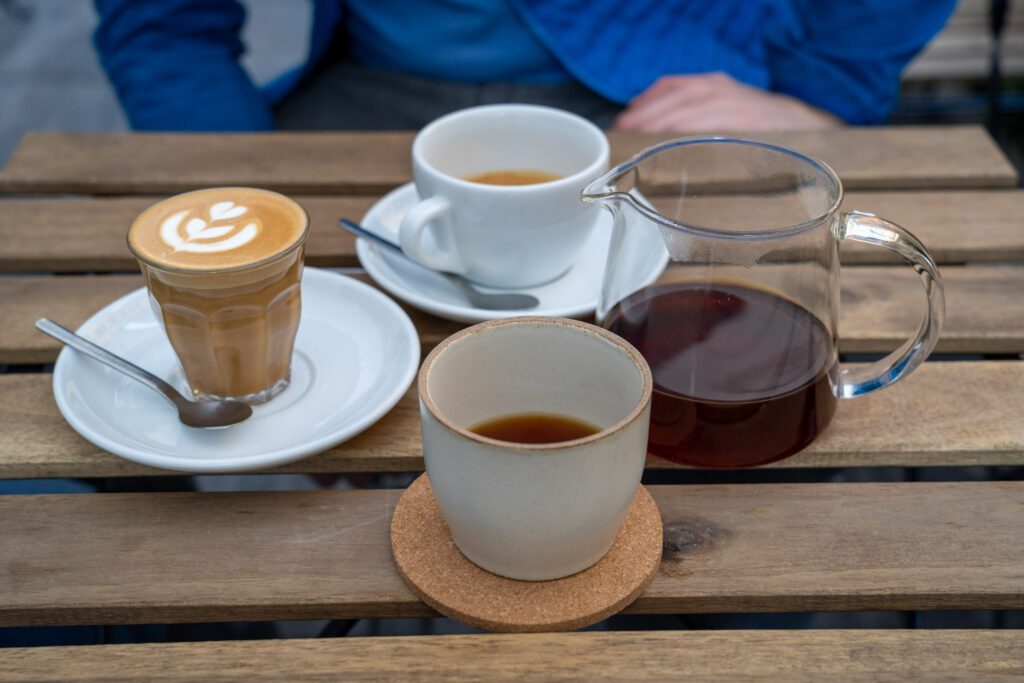
Look, you and I both know that the busy day ahead is probably going to require at least one dose of caffeine (especially if you’re coming from North America and you’re jetlagged).
Lucky for you, Matt is a coffee enthusiast (some, like Alysha, use the unflattering word “snob”), and he spent a not insignificant amount of time searching out the best specialty coffee in Milan on his last trip.
Here are his top three spots, in no particular order.
- Nowhere Coffee: Probably my number one coffee recommendation in Milan (it’s close with Orsonero), this place is VERY Instagram friendly with pops of bright color everywhere. But what about the coffee? Excellent. I brought some home to the US with me – that’s how impressed I was with the shot of espresso I enjoyed here. They roast their own beans, and they roast light, which separates them from most Italian coffee roasters.
- Orsonero: Unlike Nowhere, Orsonero does not roast their own beans, but brings in beans from some of Europe’s most prestigious roasters, including legendary Italian roaster Gardelli. It’s across the street from a park, and the interior of the cafe is tiny (and likely packed), but it spills out onto the patio outside. Very friendly people, and I got 75% of the way through my order in Italian before hitting the wall – I wanted to buy some beans, and couldn’t figure out how to say “bag.” Luckily, the barista was Canadian, and not only helped me buy coffee, but taught me how to say “bag of coffee” too, despite the long line of people behind me.
- Loste Café: A contemporary take on the traditional Italian cafe and bar, with great specialty coffee, tasty homemade pastries, and a fantastic local wine selection each evening. Walking in here feels like you could be in Copenhagen or Amsterdam (and they have used April Coffee, which is from Copenhagen). They have a fun pastry selection, too! It’s on the eastern edge of the city center, so it’s probably the least convenient of the three here.
The Mighty Milan Duomo (and Piazza del Duomo)
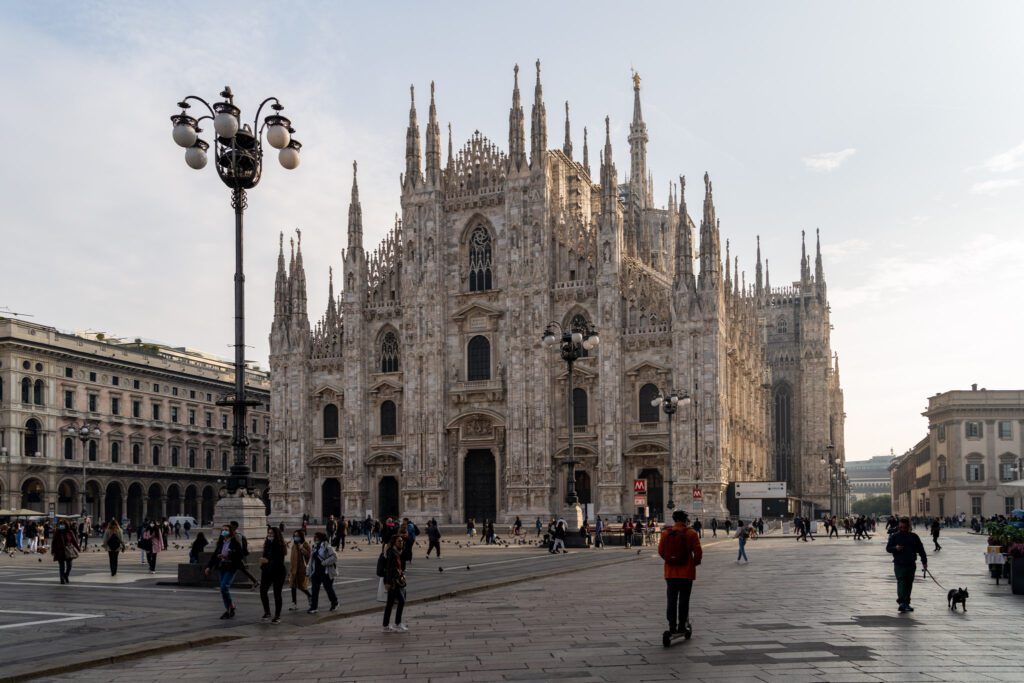
The whole area around Piazza del Duomo is best explored in the morning, before the hordes of tourists show up.
The savvy tourists book the first entry to the terraces to beat the crowds and get the best light for pictures, which is what we did, and exactly what we suggest you do.
The Milan Cathedral is the biggest church in Italy (and the third biggest in the world!).
That fact confused us at first, until we realized that the Vatican is technically a sovereign state, which means that St. Peter’s Basilica in Rome isn’t really in Italy.
The construction of Milan’s Duomo began in the 14th Century, and was finished in *checks notes* … the 20th Century? That’s six centuries!
It was built on the site of a (much) smaller cathedral that burned down in the 11th Century, and construction started in the 1300’s. The process was interrupted multiple times, mostly by different groups ascending to power or occupying the city and hitting “pause” on any construction efforts.
Funny enough, Napoleon (yes, that Napoleon) actually played a pretty big role in the efforts to finish it in the 19th Century.
He was crowned king of Italy and stayed on the throne for about a decade. His coronation actually took place at the Duomo. I enjoyed reading this, if you’re looking for a good summary of Napoleon’s foray into Italy.
The fact that it took so long to complete – and had so many different architects involved – means that the architectural style of the cathedral is all over the place.
As you can imagine, the en vogue style changed many, many times over the course of those six centuries, so it’s not all that surprising that it’s hard to place it in one specific era.
Understanding the Different Aspects of the Duomo di Milano
There are four different parts of the Duomo that you can visit, and we definitely don’t think all of them are a “must do” while you’re visiting Milan.
The Terraces
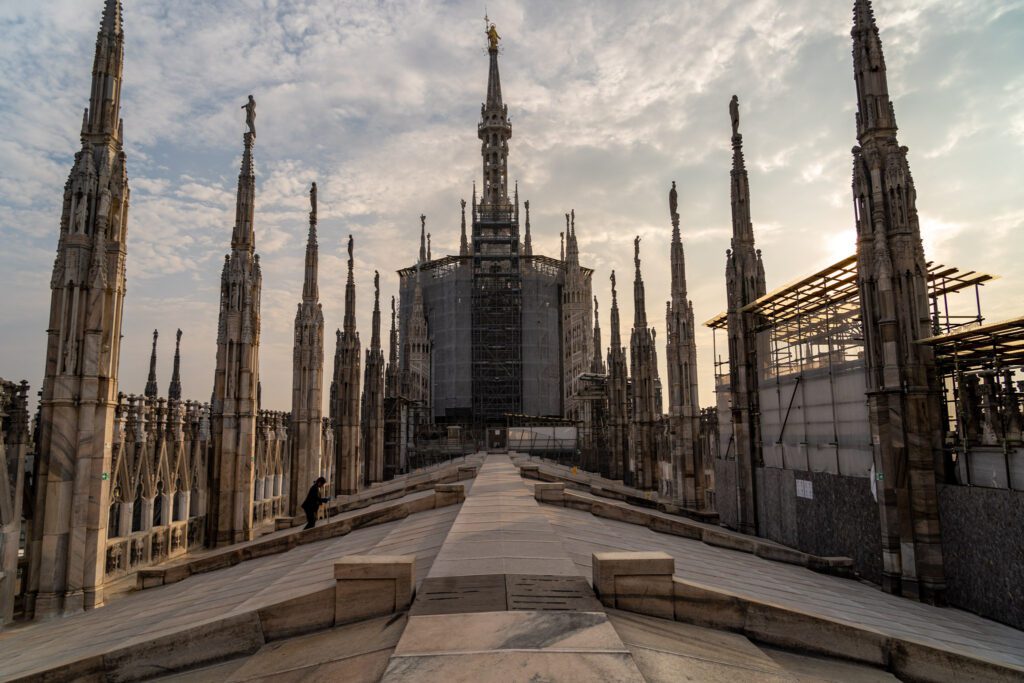
First, and the part you really shouldn’t miss, are the terraces, which you can access either by climbing a long, narrow flight of stairs (it’s not too bad – this is the way we did it) or by paying a little extra to take the elevator.
The terraces are great because they allow you to get up close and personal with all of the architectural details of the cathedral that you can barely see from Piazza del Duomo below.
For example, did you know there are unique figures standing on top of each of the cathedral’s spires?
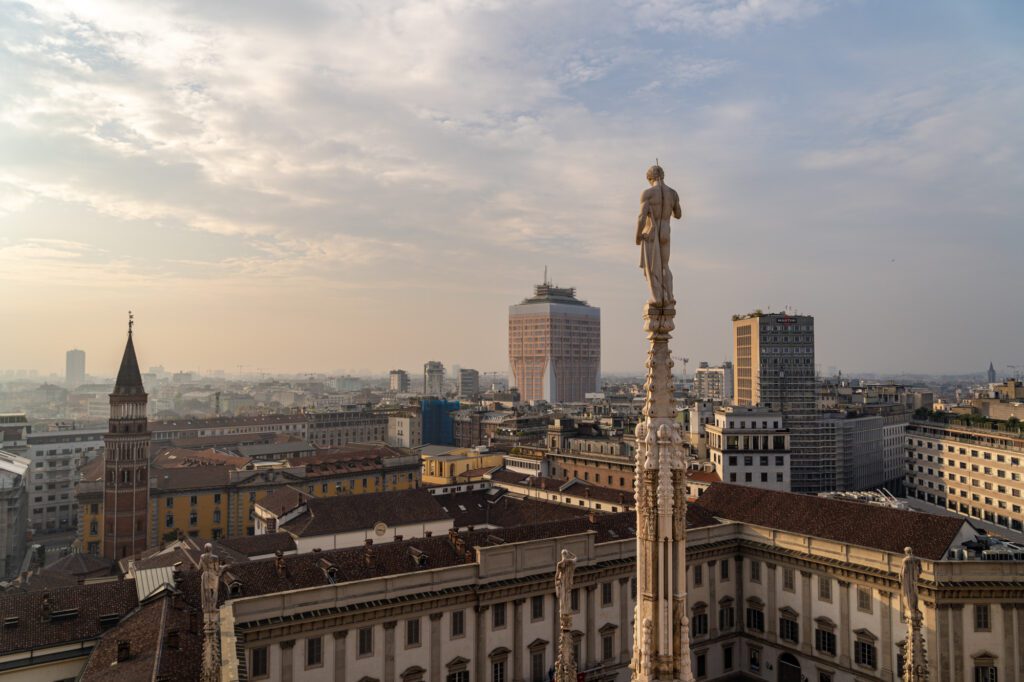
Some are clothed, others are enjoying the cool breeze on their undercarriages!
Then there’s all the creatures serving as gargoyles on the exterior of the cathedral.
Some are weird hybrid animals that, uh, must have taken some imagination (or some wild-foraged mushrooms, which is honestly probably more likely).
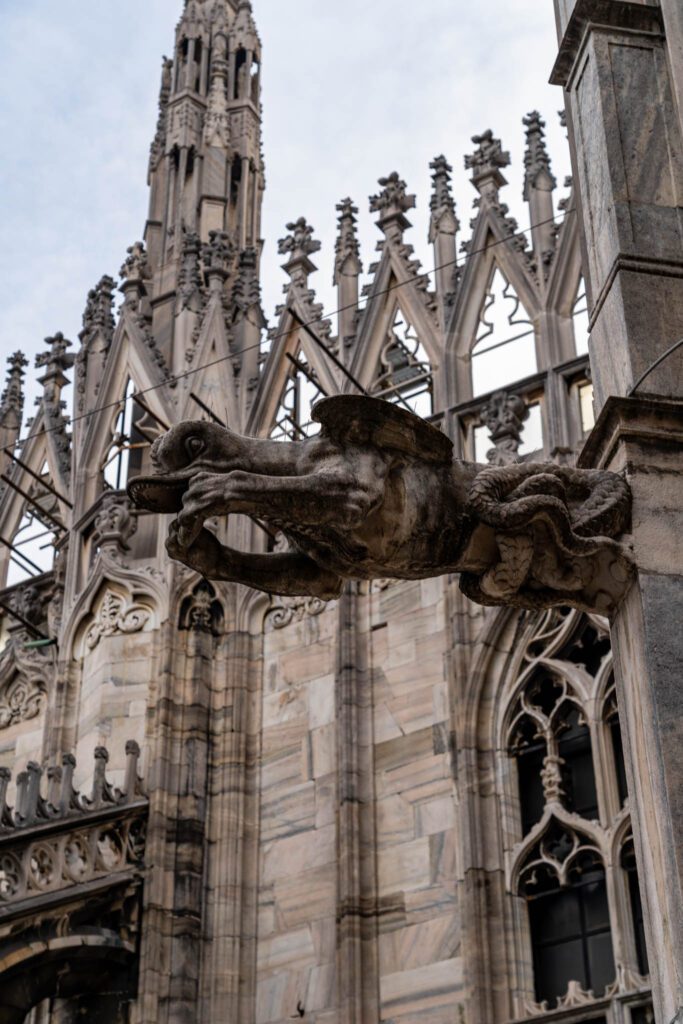
The point is that the terraces should be your main priority.
We think it’s the most unique aspect of the cathedral and, while the interior is also beautiful, with a nice collection of paintings and the usual ornate decor, we think that it’s not THAT different from other churches in Italy we’ve seen.
Maybe we should make it clear at this point that we’re not huge “see all the churches!” people. At all. One or two per city and we’re good. Which is why you won’t find every church in Milan in this itinerary. We think your time is better spent elsewhere.
Plus, visiting these churches always makes us wonder how many people could have been fed for a lifetime with the amount of wealth stored in this one massive building (the answer is a lot of people).
The Interior of the Church
Like we said, the interior of the Milan Cathedral is really not that different from a lot of the other main churches in big Italian cities.
It’s large, it’s impressive, it’s beautiful, but we could take it or leave it.
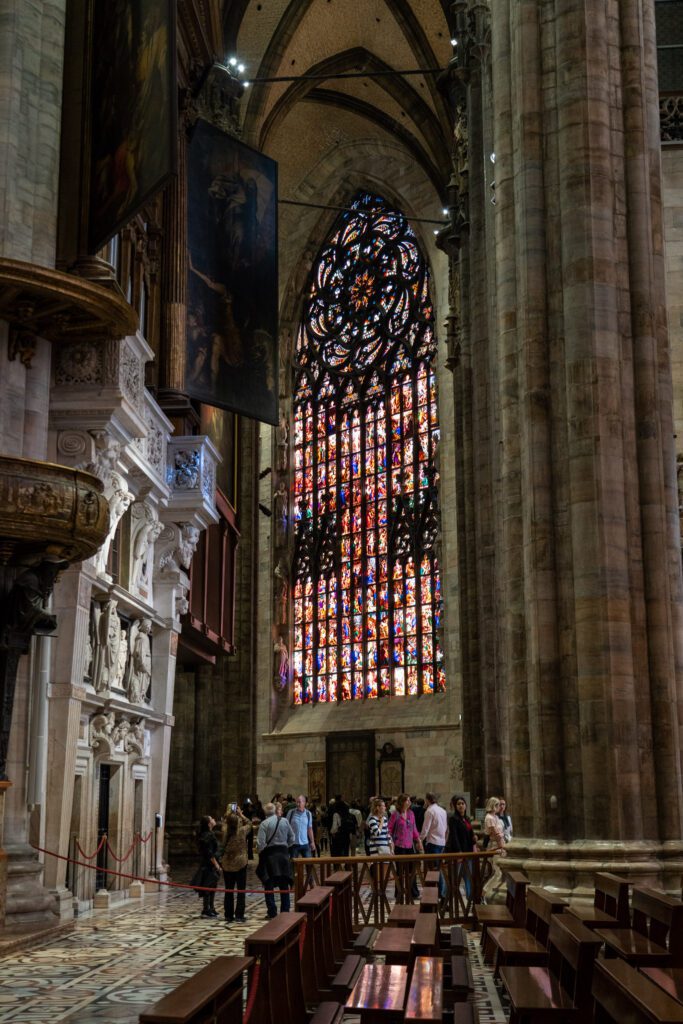
The stained glass windows are cool, and the vastness of the cathedral is somewhat unique, but if you’re feeling short on time, we’d skip it.
Or, spend ten minutes walking around, admiring the grandeur, and then move on.
The Archaeological Site and Museum
We’d say to check out the archaeological site – where you can see the footprint of the original cathedral – if you decide to spend some time on the interior of the cathedral.
We’d also say skip the museum altogether, which is located in a separate building and is only worth your time if you have a few days in Milan (and we’re not sure it is, even then).
Tips for Visiting the Duomo di Milano
There are a few things you’ll need to know before you visit.
- First, and arguably most important, is that you will be denied entry if your shoulders and knees are not covered. That means, for your day in Milan, you’ll need to plan to be wearing something that covers both (for example, pants and a t-shirt, or a sundress and a cardigan to cover your shoulders).
- The second thing to know is that the crowds in the summertime are quite something, and every last tourist wants to go to the Duomo. Lucky for you, there’s a fast track lane where you can skip the ticket line and head straight to the security line, which saves you a lot of time in the end. We bought these tickets for our trip to the terraces (buy this one instead if you want to do the interior of the cathedral too).
- Last, but certainly not least, is the fact that the climb to the terraces without the elevator requires you to climb up a long, winding staircase that is narrow and somewhat steep. Alysha gets very claustrophobic, and was totally fine, but if that climb doesn’t sound like a good time to you, then you should take the elevator, which costs a bit extra.
- It bears repeating that you should absolutely plan on being the first people up to the terraces, if you can. We did it, and it was great. Get there 20-30 minutes early to be at the front of the line (as of the time of writing, the stairs open at 9:00 am, which means you’d want to be there around 8:30 or 8:40 am). Yes, it’s early. Yes, it’s worth it.
Visit Piazza del Duomo and Galleria Vittorio Emanuele II
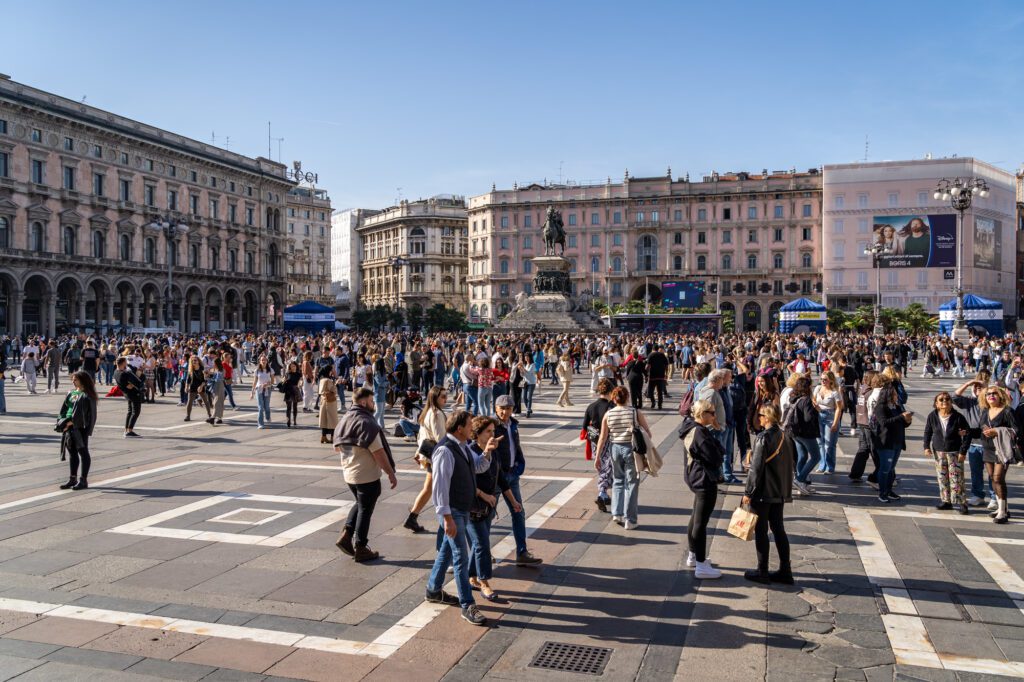
After your time exploring the Duomo, you’ll step outside into the sprawling Piazza del Duomo, which is a huge open space at the foot of Milan’s cathedral.
In the middle of it, there’s a statue of Italy’s first king, Vittorio Emanuele II, who led Italians in battle during the Second Italian War of Independence.
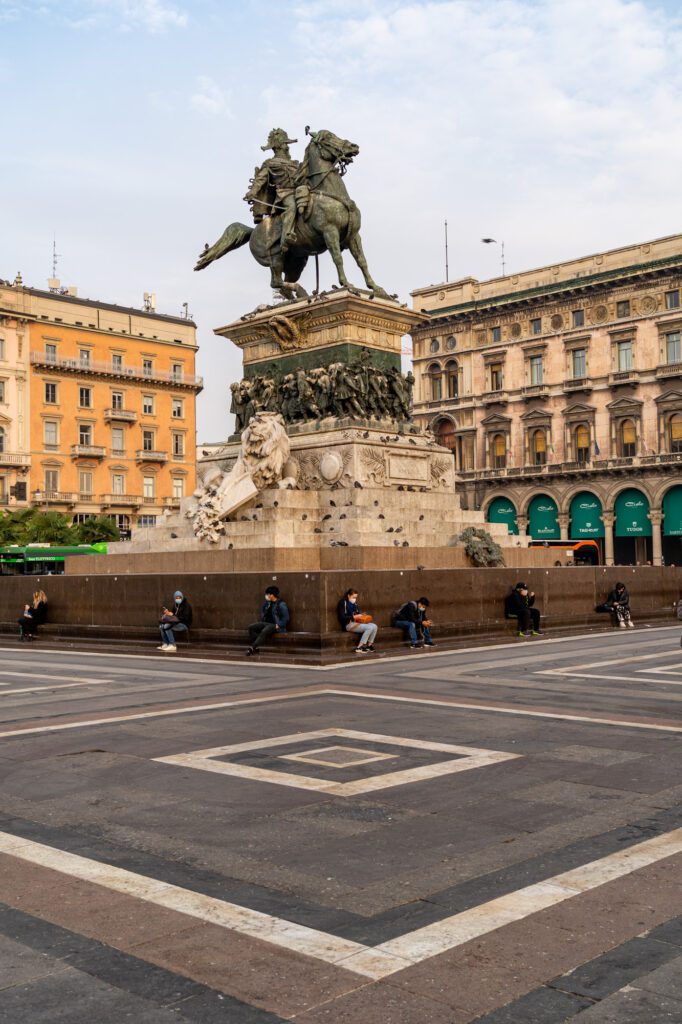
The best views of the Duomo are from the feet of this statue so that you can get the entire thing in frame, but the piazza is likely going to be littered with hundreds (maybe thousands) of people during the day.
Before you leave the Piazza del Duomo, poke your head into the Galleria Vittorio Emanuele, which is a high end mall that is about as ornate as any mall you’ll ever see in your life. Which kind of makes sense when you realize that stores like Prada have locations here (they actually have two right across from each other, which is wild).
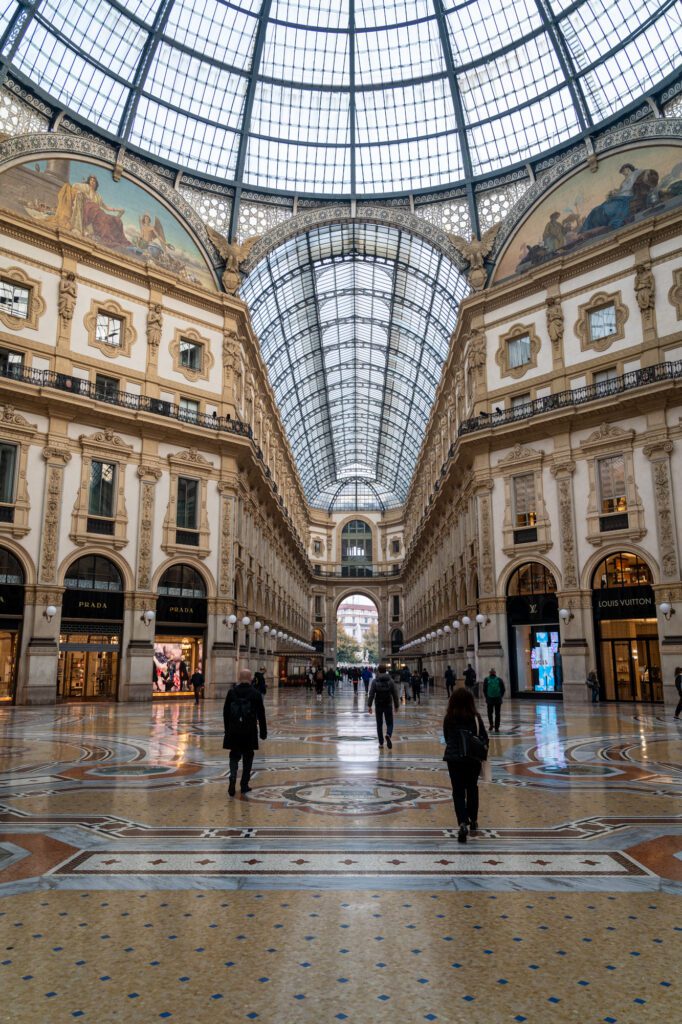
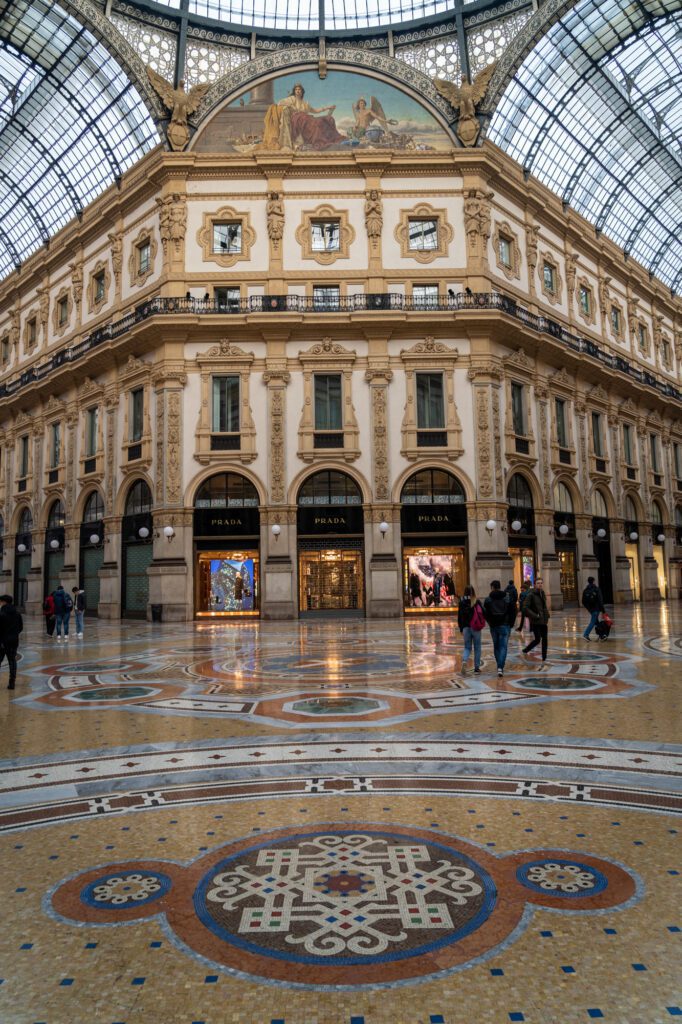
It’s a good thing to do before your climb to the terraces, because it’s packed from about 9:00 am to 7:00 pm, and it’s far less enjoyable and impressive with swarms of people around.
It should take you all of about ten minutes, if that. There’s really no need to linger.
Out the entrance on the far end of the Galleria from the Duomo, you’ll find Teatro alla Scala (it’s a few blocks down), one of the world’s most famous opera houses. It’s worth walking over to Piazza della Scala (which is right in front) to admire it from the outside even if you don’t go in.
Inside the opera house, there’s a museum and you can see the elegant interior. Here is the information on tickets and pricing. They also have guided tours most days in English at 1:00 pm, which you’ll need to book in advance (and spots are fairly limited).
Castello Sforzesco and Parco Sempione
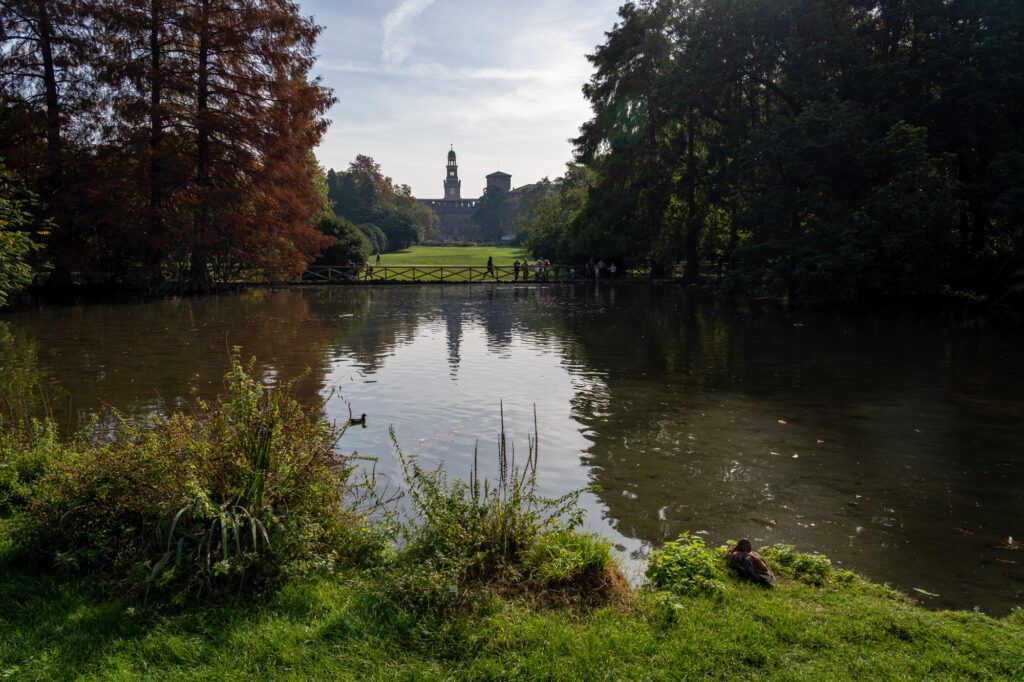
Your next stop is a nod to the medieval history of Milan – Castello Sforzesco – which was built in the 14th Century by the Duke of Milan before being transformed into a private residence by the Visconti Lords.
They invested a ton of money in decorating it with the highest quality art imaginable – including frescoes by Leonardo da Vinci, of course.
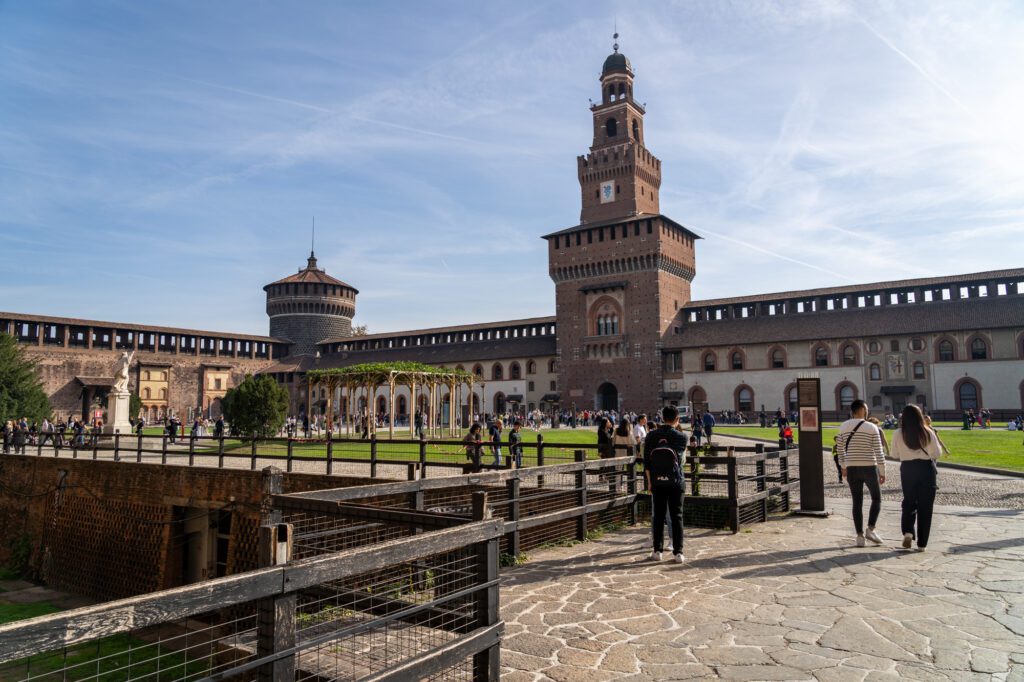
From there, it was occupied by various external forces over the years starting with the Spanish, followed by the Austrians, and finally the French under Napoleon, who had big plans to demolish the castle, but was defeated before his plans could come to fruition.
It was transferred to the city of Milan, and has undergone reconstruction over the years, most recently after Allied bombs destroyed much of the castle during World War 2.
If you only have a day in Milan, we’d opt for walking through the castle and reading the surprisingly in-depth signage over entering the museum.
If you do decide to enter the museums, focus on walking the ramparts for some nice views of the city, and the Museum of Ancient Art, where you’ll find the Rondanini Pietà, Michelangelo’s last work.
The museums – all are included under a single ticket – cost 5 Euros per person.
If you have limited time, you are only going to really have time to do one of the museums, so it’s a much better deal if you have more time in Milan and can spend some time visiting a couple of the other museums included in the price.
Then, spend some time walking through Parco Sempione, the largest green space in central Milan.
It has major Central Park vibes (of New York City fame), and even has a victory arch – the Arco della Pace – at its northern perimeter that is eerily similar to the Arc de Triomphe in Paris.
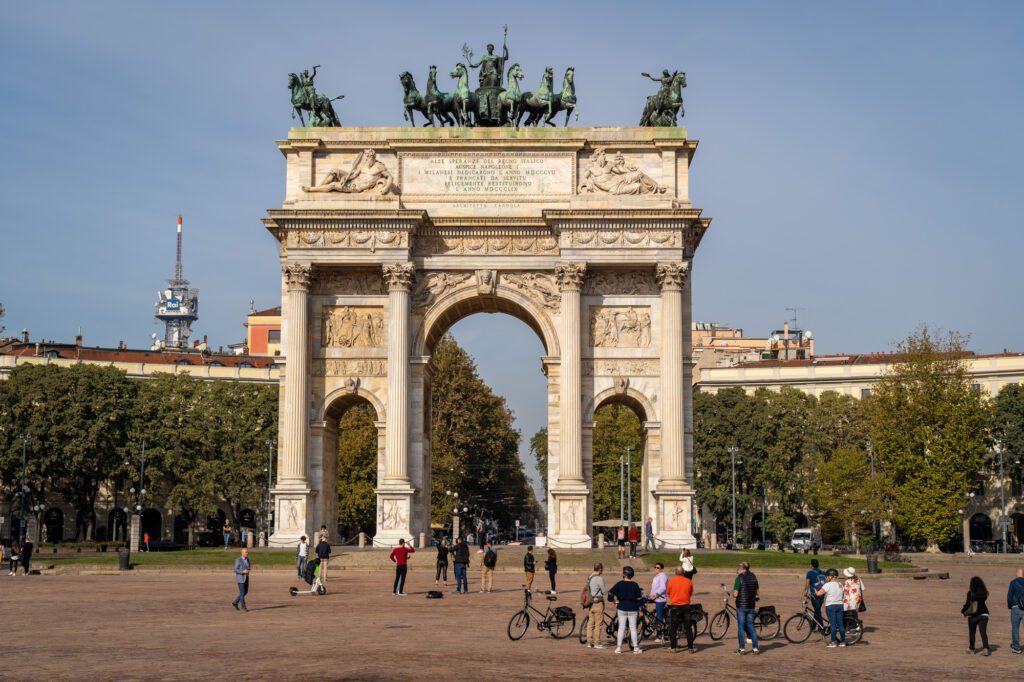
Which isn’t really surprising once you learn that it was commissioned by, you guessed it, Napoleon (though it was completed after Napoleon left Milan).
Every big city needs a victory arch, apparently!
The park is great to stroll through – don’t miss the pond in the middle with the Ponte delle Sirenette (bridge of the mermaids, roughly).
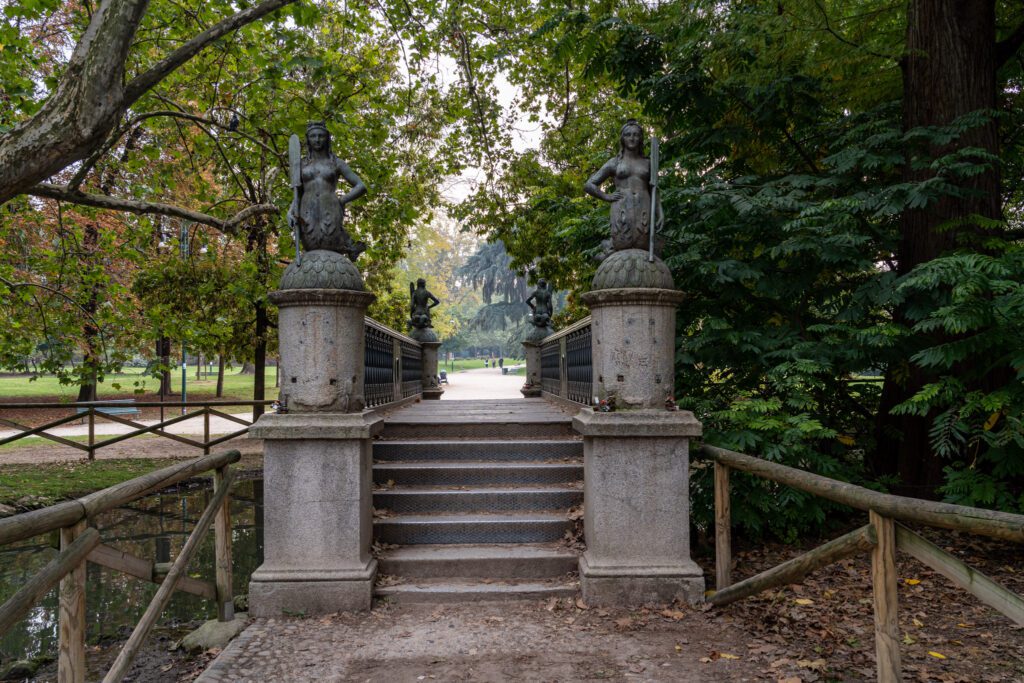
We were there in the fall and the cool, crisp fall air and changing colors on the leaves of the trees was a lovely break from the hustle and bustle of Milan.
After the park, break for lunch.
Our recommendations near the park are either Maison Bretonne (French crepes northwest of the arch, in honor of Napoleon), Peck + Ciacco (a gourmet grocery store and a famous gelato shop in the center – here on Google Maps), or La Prosciutteria (east of the park in Brera – we went to their location in Siena for light bites and enjoyed it).
Santa Maria delle Grazie and Leonardo Da Vinci’s Last Supper
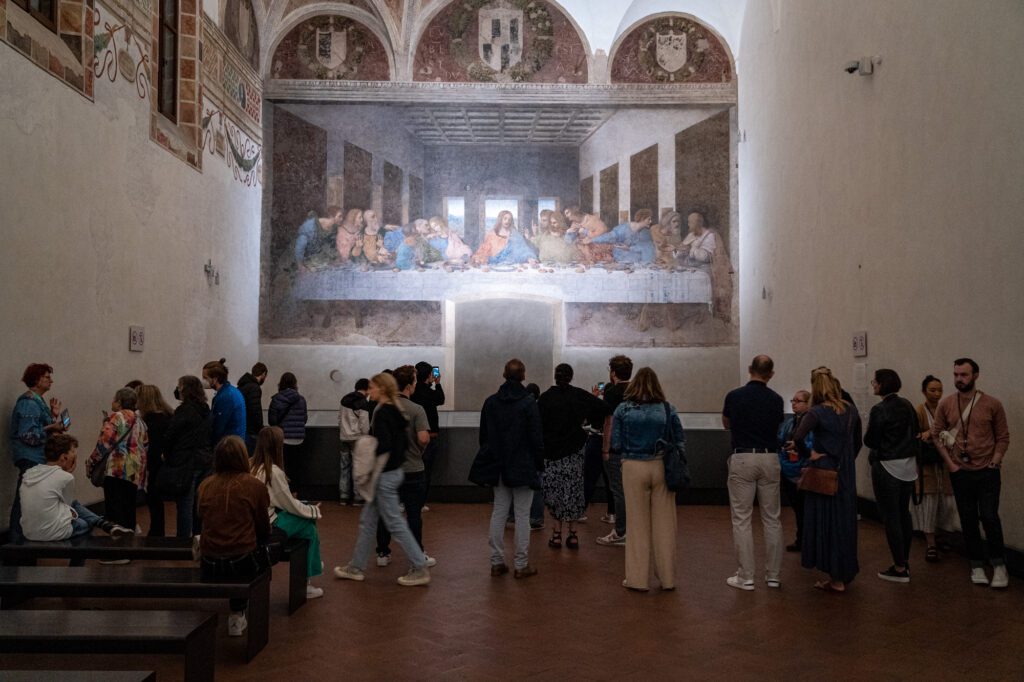
The Last Supper is simultaneously Milan’s most famous attraction and the attraction that is hardest and most complicated to get tickets for. It’s tucked away inside a small church – Santa Maria delle Grazie – in the southwestern end of the city center.
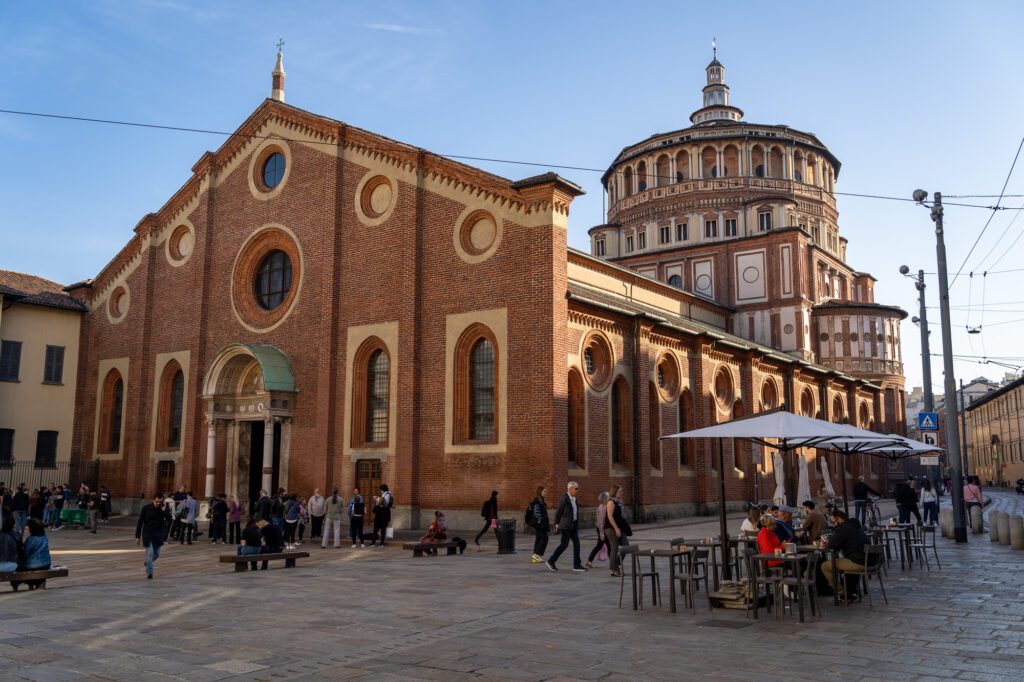
The Last Supper was painted by Da Vinci in the 15h Century (though it has apparently been updated since, which we learned on our tour) and depicts Jesus and his disciples having, well, a last supper.
According to the story, the scene is notable because Jesus tells them that one of them will betray him (and sure enough, Judas does).
On my recent trip to Milan with my mom and brother, the Last Supper was THE thing that my mom wanted to do in Milan – it has been on her bucket list for years.
Since I hadn’t gotten to see it on my earlier trips to Milan, I went to get tickets for a Saturday in October a month in advance, and found that they were entirely sold out.
In order to protect the painting, entry is VERY limited.
This is the most complicated part of this entire Milan itinerary, so prepare to take notes.
The tickets to see the Last Supper, a masterpiece by Leonardo Da Vinci and quite possibly one of the most famous paintings in the world, are nearly impossible to get. Entries are severely limited, and tour companies get first crack at them, leaving few for the independent travelers.
For context, tickets come in 15 minute time slots, and there are about 25 people allowed per time slot. Which is not a lot of people when you consider the fact that thousands of tourists come to Milan every day hoping to see it.
On the bright side, we have a few solutions for you, from snagging tickets on your own, to joining a guided tour that includes tickets, which is what we ended up having to do in order to see it with my mom.
For what it’s worth, we did enjoy the tour with our favorite tour company in Italy, Walks of Italy – it was this tour if you’re interested.
Let’s talk about the Last Supper and how to see it.
Important Note: Like the Duomo, you will be denied entry to see the Last Supper if your shoulders and knees are not covered, so make sure to dress appropriately for your day in Milan!
Getting Tickets on Your Own
During the summer, which is the busiest time in Milan, tickets will sell out months in advance. It is absolutely mandatory to book as far in advance as humanly possible in the summer.
Tickets are available on this website. Yes, it’s the official website. Yes, it looks like it was designed in 2006.
The biggest problem is that there is no set date when tickets go on sale (e.g. three months in advance). Instead, you’ll have to check back at the website (linked above), which gives a date range that tickets are available for.
To make things more complicated, I’m sitting here at the end of October, and tickets haven’t been released past October 31st (which is 10 days away).
Tickets for weekends in the offseason still sell out, so you’ll need to pay attention even if you’re not coming to Milan in the summer.
At the time of writing, tickets to see the Last Supper cost 15 Euros per person, plus a 2 Euro service fee. Reduced price tickets are just 2 Euros (for EU residents between 18 and 25), and tickets for minors are free (you still need a reservation, though).
Here’s what the ticket site looks like.
This is what the booking site should look like, with availability in green for whatever dates you choose
Note that you will have to show up 15 minutes early at the ticket desk to grab your tickets, even if you booked them in advance. There can be long lines in peak season, so budget some extra time to get there early.
Joining a Guided Tour
If you’re planning your visit to Milan at the last minute, or are just doing the research now on how to see the Last Supper for an upcoming trip, you might be saying “ah, guess I won’t be able to see it after all” at this point.
That’s exactly where we found ourselves when I checked a month in advance and found the tickets entirely sold out.
The good news is that there’s another option for seeing the massive piece of art. The bad news is that it’s going to be significantly more expensive.
But if you aren’t able to get tickets on your own and seeing the Last Supper is a must-do while you’re in Milan, you don’t really have another choice.
Plus, over the past few years of spending a lot of time in Europe, we’ve found that guided tours of art museums are the way to go if you can afford the extra expense.
The expert guide will bring context and storytelling to the table which inevitably leads to a much richer experience and understanding of the significance than us just standing in front of a painting going “yep, that’s a cool painting, I guess.”
So while it’s going to be more expensive, it’s not like you’re just getting price gouged. You’re getting something extra for your money, we think.
There are two options under this “guided tour” heading, and they are joining a tour that only covers the Last Supper (like this one), or joining a broader Milan walking tour that takes you around to multiple sites (like this one).
Personally, we chose this tour with Walks of Italy (also known as Take Walks outside of Italy), our favorite tour company in Europe (you can read about our Colosseum tour in Rome and our Louvre tour in Paris to understand why).
This tour includes skip-the-line entry to the Last Supper AND the interior of the Milan Cathedral, along with some other sites in between.
All with an expert local guide, who will help add depth to the experience, and take you to some places that you never would have discovered on your own (our guide is how we discovered Peck and Ciacco Gelato).
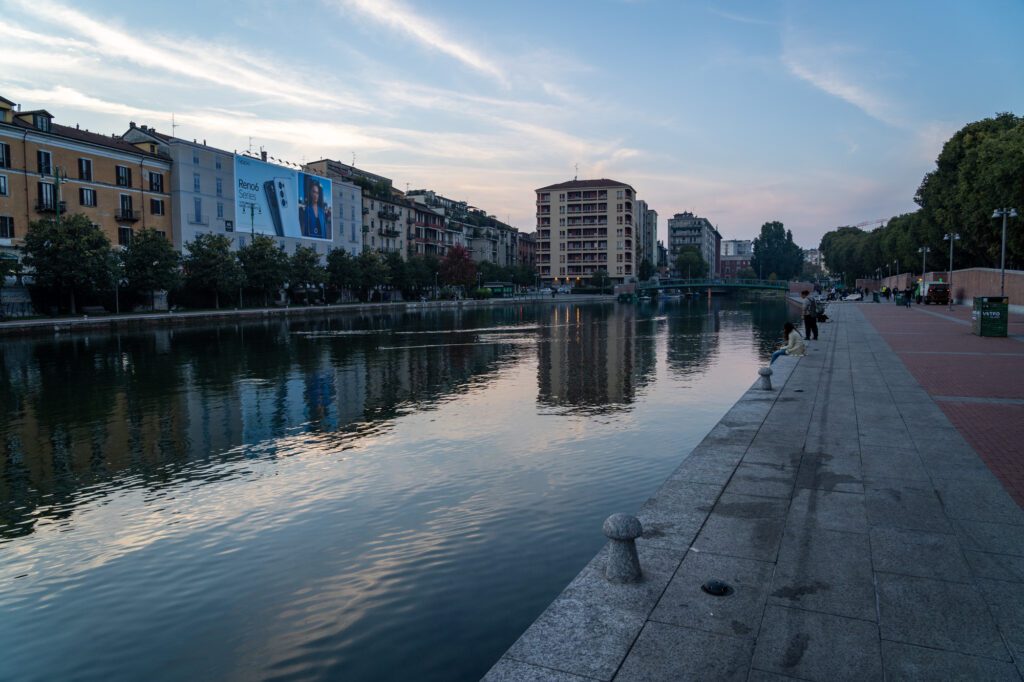
Milan joins Paris and Venice (among many other cities in Europe) in the category of “has a system of canals that are begging you to have an afternoon drink near them.”
The Navigli, as they’re referred to in Milan, are a system of canals that were originally used for irrigation, but quickly became a main shipping thoroughfare when people realized it was easy to send goods to the center of Milan via the interconnected waterways.
The stone to build the Duomo, for example, was sent through the canals.
However, in the 20th Century post World War 2, the importance of the canals diminished significantly (and portions were filled in and covered) with the increase in the efficiency of transport by road.
Today, they’re mainly just a really nice place to grab a drink in the afternoon and early evening (though it is still used for irrigation).
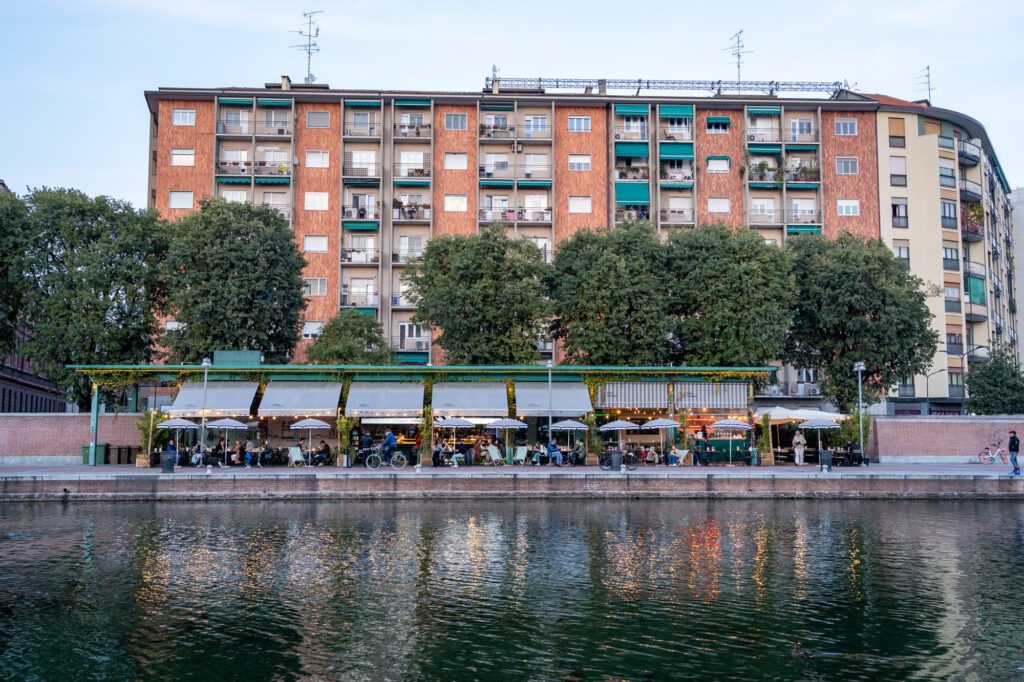
There are numerous places to grab a drink – we’d recommend either a spritz or a negroni – along the canals.
We’d highly recommend walking a loop that takes in Naviglio Grande, the biggest and most interesting of the canals.
Start from the Arco di Porta Ticinese, head west around the Darsena di Milano, a small reservoir, cross over the bridge and down one side of the canal, then come back along the other side.
Confused? Here’s a map of what that walk looks like.
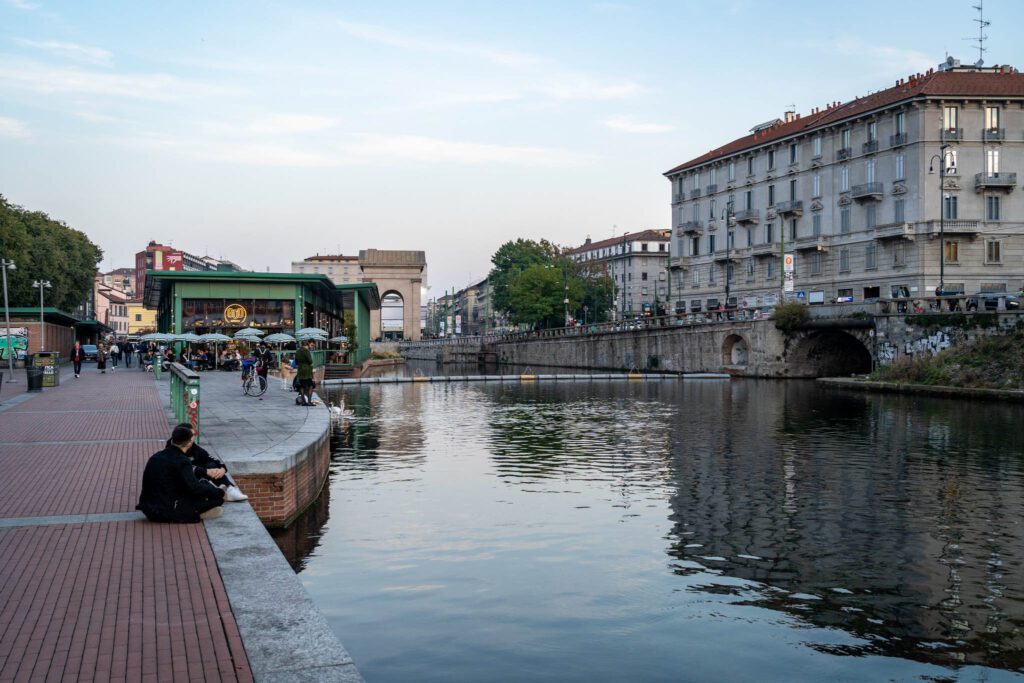
Our favorite spot in the neighborhood wasn’t actually along the canals, but was a few blocks away.
It’s called e/n enoteca naturale, and they have a gorgeous location with an outdoor garden that has views of Basilica di Sant’Eustorgio, which is directly behind the garden. Great natural wines by the glass, and they even have a rotating cider (we LOVE cider!).
For freshly baked Italian pizza, check out popular Berberè Navigli, while Osteria del Gnocco Fritto on Naviglio Grande specializes in delicious fried dumplings, served with cold meat, cheese, or homemade jam.
There are also a surprising number of good Japanese spots in Milan, like Bentoteca which is relatively close to the canals.
For drinks on the canals themselves, there’s a series of bars along the north side of the reservoir that offer good views over the water. There are also plenty of places along either side of Naviglio Grande with eager hosts waiting to offer you a table.
What to Do with More Than a Day in Milan
If you have an extra day or two in Milan, the first thing we’d do is point you to our 2 day Milan itinerary where we’ve created a more leisurely version of this itinerary, with a few of Milan’s hidden gems that we really enjoyed (including seeing some of Leonardo Da Vinci’s sketches!).
If you have 3-4 days in Milan, we’d recommend spending one of them on a day trip to another city in Northern Italy.
Our top three day trip recommendations would be Lake Como (which isn’t really a city, I guess), Verona (one of our favorite cities in Italy – read more in our Verona guide), and Turin (we haven’t been YET, but we’ve heard great things).
Another option would be Bologna, which is our favorite city in Italy (the food is INCREDIBLE) and is an easy one hour high speed train ride from Milan. Here’s our guide to one day in Bologna for exactly how to spend your day there..
Where to Stay in Milan
If you’re lucky to have enough time to spend the night in Milan, we’d STRONGLY recommend that you base yourself near Milano Centrale, which is not the coolest neighborhood, but is definitely the most convenient for getting in and out of the city by both train and plane.
P.S. we have an entire guide dedicated to figuring out where to stay in Milan based on your specific style and budget, which you should read if you’re interested in more detail behind that recommendation.
Staying here will avoid long journeys to and from the train station to catch your train (either to another city, or to the airport), and it has excellent transit connections to the rest of the city.
For what it’s worth, we’ve stayed here (twice) and haven’t regretted it one bit either time.
On our first trip we stayed at Ostello Bello Grande, a very nice hostel a block away from the train station with a lovely rooftop patio and both bunks and private rooms (we chose the latter).
On my latest trip, I stayed at Hotel IQ with my mom and brother, and it was also great – comfortable beds, friendly staff, and a good value.

The restaurants you mention in Milan look delicious but not necessarily good for someone with celiac. Do you have recommendations on what to order?
Thank you for your blog! We will be in Italy next month and I’ve bookmarked many of your pages!
Hey Jean! Sorry we’re only getting to this not, but we have an entire guide dedicated to eating gluten free in Milan, which would be the place to go to find gluten free restaurants. Cheers!